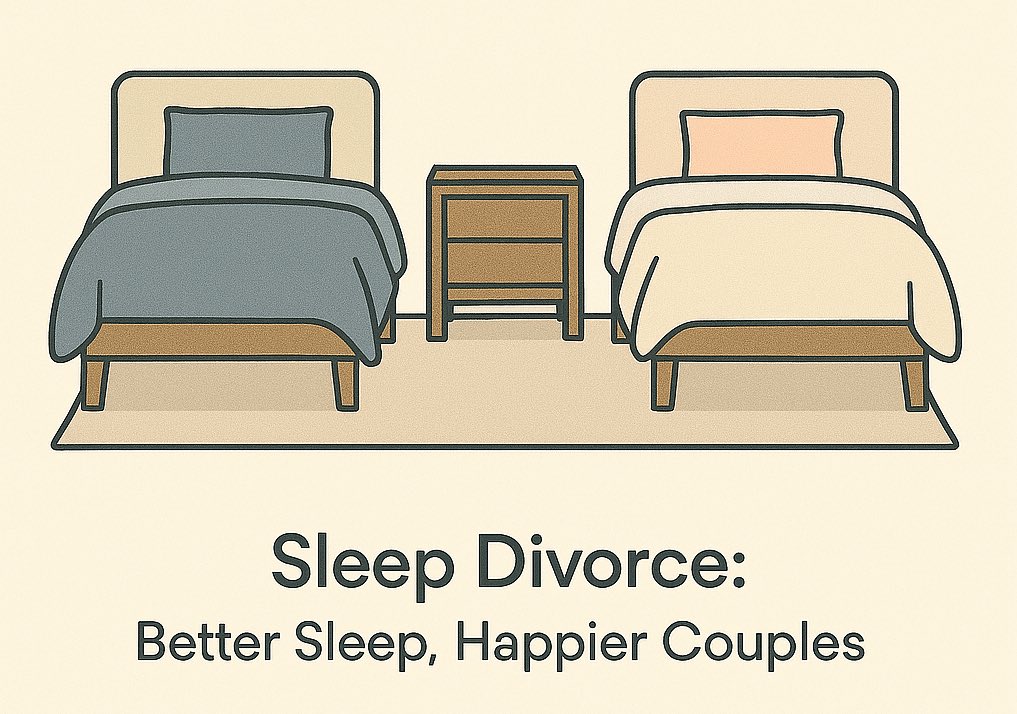Sleep Divorce: The Secret to a Happier Relationship (and Better Sleep)
It may sound dramatic, but a sleep divorce might just be the best thing to happen to your relationship—and your health. More and more couples are choosing to sleep in separate beds or even separate bedrooms, not because of emotional distance, but in the name of better rest. If snoring, blanket-hogging, or conflicting schedules are causing nighttime tension, sleep divorce could be your dream solution.
Let’s break down what it means, who it’s for, and how to make it work without losing intimacy or connection.

🛏️ What Is Sleep Divorce—and Why Are Couples Choosing It?
Sleep divorce simply means sleeping apart from your partner to get better quality rest. This doesn’t mean you’re emotionally disconnected—it just means you’ve prioritized sleep as a non-negotiable need.
Common reasons include:
- One partner snores, tosses and turns, or hogs the covers
- Different sleep schedules (e.g. night owl vs early riser)
- Light sleepers who wake up from even small movements
- Temperature preferences (hot vs cold sleeper)
- Children, pets, or sleep disorders interfering with rest
It’s a growing trend backed by science: good sleep improves mood, memory, libido, and even how we relate to our partners.
👥 Who Should Consider a Sleep Divorce?
Sleep divorce works especially well for:
- Couples with radically different sleep needs
- Light sleepers who wake easily
- Shift workers or partners with opposite routines
- Couples dealing with sleep apnea or snoring
- Parents with newborns who want to rotate responsibility
- Anyone feeling frustrated or resentful due to poor sleep
Spoiler alert: it’s not just for couples in trouble. Many happy, healthy relationships have adopted sleep divorce as a proactive self-care strategy.
✅ Pros and Cons of Sleep Divorce
✔ Pros:
😴 Better sleep quality = better mood, focus, and health
💖 Improved relationship thanks to reduced irritation and resentment
🌡 Custom sleep environment (lighting, temperature, mattress)
🧠 More energy and patience for your partner during the day
✘ Cons:
🛌 Less spontaneous intimacy (but you can schedule it!)
💬 Social stigma — some worry what others will think
🏠 Space limitations — not everyone has a spare room
🧩 How to Do Sleep Divorce the Right Way
It’s not just about moving to the guest room. To succeed, you need communication, clarity, and comfort.
Here’s how to make it work:
- Talk openly with your partner—frame it as a health decision, not a rejection
- Decide on the arrangement: separate beds in the same room, or different rooms entirely
- Choose the right mattress and bedding—optimize for your preferences
- Maintain emotional and physical intimacy in other ways
- Check in regularly to make sure it’s still working for both of you
📏 Best Bed Sizes for Sleep Divorce
If you’re staying in the same room but using two beds, or just want a little more personal space, choosing the right size is key.
Best bed sizes for couples practicing sleep divorce:
- Twin XL (38″ x 80″) x 2: Combine two for a Split King setup—great for adjustable bases
- Full or Queen per person: If you have a larger room, this gives you solo space and luxury
- Alberta King or Alaskan King: One massive mattress for couples who want distance without leaving the bed
Want to stay in the same bed but reduce motion transfer? Look for hybrid or memory foam mattresses that isolate movement.
💡 Pro Tips for Sleep Divorce Success
🕯 Create rituals for connection, like morning coffee or evening chats—even if you don’t sleep together
🧺 Design both sleep spaces beautifully—this is about luxury, not punishment
🎯 Set boundaries and revisit often—sleep needs can change
🔄 Try it for a few nights a week first, then scale up if it works
🔊 Use white noise machines, blackout curtains, and climate control to personalize your space
❤️ Final Thoughts: Sleep Divorce Isn’t the End — It Might Be a New Beginning
At the end of the day (literally), sleep is essential. When poor rest causes stress, arguments, or exhaustion, your relationship suffers more than it helps. A sleep divorce could be the key to waking up refreshed, energized, and genuinely happy to see each other again.
After all, the best couples don’t always sleep together—they just wake up better.